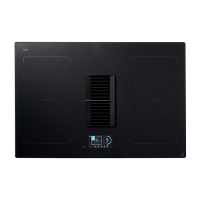21
EN Installation
PL Montaż
FR Installation
RO Instalare
EN
Installation
Caution:
This appliance must be installed by a qualified person in compliance with the instructions provided. The manufacturer
declines all responsibility for improper installation, which may harm persons and animals and cause damage.
• This appliance must not be installed directly above a dishwasher, fridge, freezer, washing machine, oven or clothes
dryer as the humidity may damage the hob electronics.
• Do not attempt to dismantle the appliance, there are no user servicable parts inside.
• At the end of its life, the appliance should not be disposed of in household waste; contact your Local Authority
for guidance.
• Check the package and make sure you have all of the parts listed.
• Decide on the appropriate location for your product.
Important: If the room contains a fuel burning appliance, such as a gas, or oil fired, central heating boiler, which is not of
the 'Balanced Flue' type, you should make sure that there is adequate air inlet into the room at all times so that fumes
from the boiler are not drawn back into the room by the Cooker Hood.
The specifications plate is available on this appliance. This plate displays all the necessary identification information for
ordering replacement parts.
If you sell the appliance, give it away, or leave it behind when you move house, make sure you also pass on this manual
so that the new owner can become familiar with the appliance and its safety warnings.
Caution:
• This hob must be connected to the mains power supply only by a suitably qualified person.
• Before connecting the hob to the mains power supply, check that:
1. The domestic wiring system is suitable for the power drawn by the hob.
2. The voltage corresponds to the value given in the rating plate.
3. The power supply cable sections can withstand the load specified on the rating plate.
• To connect the hob to the mains power supply, do not use adapters, reducers, or branching devices, as they can
cause overheating and fire.
• The power supply cable must not touch any hot parts and must be positioned so that its temperature will not
exceed 75°C at any point.
• The work surface is square and level, and no structural members interfere with space requirements.
• The work surface is made of a heat-resistant material.
• The installation will comply with all clearance requirements and applicable standards and regulations.
• A suitable isolating switch providing full disconnection from the mains power supply is incorporated in the
permanent wiring, mounted and positioned to comply with the local wiring rules and regulations. The isolating
switch must be of an approved type and provide a 3 mm air gap contact separation in all poles (or in all active
[phase] conductors if the local wiring rules allow for this variation of the requirements).
• The isolating switch will be easily accessible to the customer with the hob installed.
• You consult local building authorities and by-laws if in doubt regarding installation.
• You use heat-resistant and easy-to-clean finishes (such as ceramic tiles) for the wall surfaces surrounding the hob.
When you have installed the hob, make sure that:
• The power supply cable is not accessible through cupboard doors or drawers.
• There is adequate flow of fresh air from outside the cabinetry to the base of the hob.
• If the hob is installed above a drawer or cupboard space, a thermal protection barrier is installed below the base of
the hob.
• The isolating switch is easily accessible by the customer.
• The hob should be fixed into the worktop using the fixing brackets and sealing tape supplied with the appliance.
Do not use silicone sealant or PVA to secure the hob. Doing so will prevent an engineer removing the appliance to
facilitate a repair.

